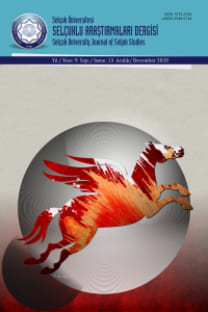ABDÜLLATÎF el-BAĞDÂDÎ’NİN KİTÂB el-İFÂDE ve’l-İʿTİBÂR İSİMLİ ESERİNDE GEMİLER, NİL NEHRİ VE NİLOMETRE HAKKINDA VERDİĞİ BİLGİLERE DAİR
Abdüllatîf el-Bağdâdî, , Kitâb el-İfâde ve’l-İʿtibâr, , gemiler, , Nil Nehri, , Mikyâsü’n-Nîl [Nilometre]
ABOUT SOME INFORMATION GIVEN FOR THE SHIPS, THE NILE RIVER AND THE NILOMETER IN ʻABD al-LATĪF al-BAGHDĀDI’S WORK WHICH IS TITLED KITĀB al-IFĀDAH wa’l-IʻTIBĀR
___
- Abdüllatîf el-Bağdâdî, Kitâb el-İfâde ve’l-İʿtibâr, Arapça metin ve İngilizce trc. Kamal Hafuth Zand-John A. Videan-Ivy E. Videan, The Eastern Key, Kitāb al-Ifādah wa’l-Iʻtibār of ʻAbd al-Latīf al-Baghdādi, London 1965.
- Agius, Dionisius A., Classic Ships of Islam from Mesopotamia to the Indian Ocean, Leiden-Boston 2008.
- Akgür, Necati, “Bilim Tarihi Tarih Boyunca Türklerin Kullanmış Oldukları Takvimler-3 Eski Mısır Takvimi ile Bundan Alınan Kıptî Takvimi Eski Fars ya da Yezdücerd Takvimi”, Türk Dünyası Araştırmaları Dergisi, S. 74, İstanbul 1991, s. 157-194.
- Fahmy, Aly M., Muslim Sea-Power in the Eastern Mediterranean from the Seventh to the Tenth Century A.D. (Studies in Naval Organisation), London 1950.
- Farag, Lois M., The Coptic Christian Heritage: History, Faith and Culture, New York 2015.
- Gabra, Gawdat, The A to Z of the Coptic Church, Maryland 2009.
- Hâmidullah, Muhammed, “Dîneverî, Ebû Hanîfe”, DİA, IX, İstanbul 1994, s. 356-358.
- Houtsma, Martijn Theodoor, “Abdüllatîf”, İA, I, Milli Eğitim Basımevi, İstanbul 1978, s. 92. Kaya, Mahmut, “Abdüllatîf el-Bağdâdî”, DİA, I, İstanbul 1988, s. 254-255.
- Kaya, Mahmut-Sâmî Şelhûb, “Fergāni”, DİA, XII, İstanbul 1995, s. 377-378.
- Kaya, Mahmut, “el-İfâde ve’l-İʿtibâr”, DİA, XXI, İstanbul 2000, s. 504-505.
- Kaya, Mahmut, “İşrâkıyye”, DİA, XXIII, İstanbul 2001, s. 435-438.
- Kaya, Mahmut, “Mikyâsü’n-Nîl”, DİA, XXX, İstanbul 2005, s. 52-53.
- Klein, Herbert Arthur, The Science of Measurement: A Historical Survey, New York 1988.
- Kramers, Johannes Heindrik, “al-Nil”, EI2, VIII, 2004, s. 37-43.
- Kutluer, İlhan, “Câlînûs”, DİA, VII, İstanbul 1993, s. 32-34.
- Kutluer, İlhan, “Sühreverdî, Maktûl”, DİA, XXXVIII, İstanbul 2010, s. 36-40.
- Muntasır, A., “el-İfâde ve’l-iʿtibâr”, Türâsü’l-insâniyye, I, Kahire 1971, s. 116-122.
- Nüheylî, Derviş, es-Süfünü’l-İslâmiyye ‛alâ hurûfi’l-muʻcem, İskenderiye 1974.
- Ruska, Julius-Donald R. Hill, “Miqyās”, EI2, VII, 2004, s. 39-40.
- Stern, Samuel Miklos, “ʿAbd al-Laṭīf al-Bag̲h̲dādī”, EI2, I, 1998, s. 74.
- Seyyid, Eymen Fuad, “Nil”, DİA, XXXIII, s. 122-123.
- Thompson, Ambler, Guide for the Use of the International System of Units (SI), Gaithersburg 2008.
- Tok, Özen, “Osmanlılarda Kıptî Takviminin İdarî ve Malî Alanda Kullanımı”, Erciyes Üniversitesi Sosyal Bilimler Enstitüsü Dergisi, S. 21, 2006, s. 365-379.
- Uludağ, Süleyman, “İşrâkıyye”, DİA, XXIII, İstanbul 2001, s. 438-439.
- Walzer, Richard, “D̲j̲ālinūs”, EI2, II, Oxford 1962, s. 402-403.
- Ziai, Hossein, “al-Suhrawardī”, EI2, IX, 1997, s. 782-784.
- ISSN: 1015-2105
- Yayın Aralığı: Yılda 2 Sayı
- Başlangıç: 1986
- Yayıncı: Selçuk Üniversitesi
ORTA ASYA OĞUZ BOYLARI TARİHİNİN BAZI MESELELERİ
XII. YÜZYIL BİZANS ANADOLUSU’NDA KENTSEL EKONOMİ: TEMEL DİNAMİKLER VE PERGAMON ÖRNEĞİ
BÜYÜK SELÇUKLULAR VE HÂREZMŞAHLAR DEVRİNE AİT AZ BİLİNEN BİR KAYNAK: CEVÂHİR-NÂME-Yİ NİZÂMÎ
BÜYÜK SELÇUKLULAR DÖNEMİ’NDE HEMEDAN’IN SİYASİ TARİHİ
ARAPÇA TARİH KAYNAKLARININ TERCÜME PROBLEMİNE BİR ÖRNEK: İBN KALÂNİSÎ ŞAM TARİHİNE ZEYL
